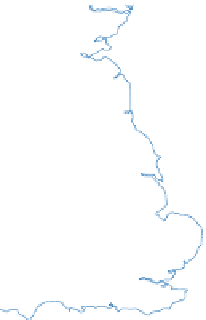Geoscience Reference
In-Depth Information
Figure 17.19
Estimated potential sea-level
rise by
AD
2100, attributable to
principal sources and showing
Source: After Ince (1990)
Greenland ice sheet
50
Thermal expansion
30
20
10
0
40
30
20
10
2000
2050
Year
2100
90
0
Antarctic ice sheet
2000
2050
Year
2100
80
70
60
50
40
30
20
10
Glaciers and small
ice caps
40
30
20
10
0
0
2000
2050
Year
2100
2000
2050
Year
2100
0
100
200
barriers, face direct attack by the sea as it mounts the
final assault on continental land surfaces by sub-aerial
processes. Wave erosion causes the coastline to retreat at
rates determined by effective wave energy and geological
resistance. Wave conditions, tidal influence and tectonic
settings were described earlier. The erosion front is
normally marked by a cliff and a trail of residual land-
system components marking its retreat (
Figure 17.21
).
Assuming constant sea level, marine erosion is con-
centrated towards the cliff base and may be represented
initially by a
wave-cut notch
. This will eventually
destabilize overhanging rock to the point of failure and
the process continues once wave action has removed the
debris. Wave action may account directly for up to 25 per
cent of cliff erosion; mass wasting triggered indirectly
by wave action, and other erosion accounts for the
remainder. Net evacuation of eroded debris and any
longshore sediment influx is an important requirement
for continuing erosion, without which
effective
wave
energy is reduced to zero. Cliff retreat leaves behind a
rock
platform
. Its extent is determined by effective wave depth
and the degree of water layer and biotic weathering,
particularly during exposure at low tide. Platforms may
be horizontal, or slope gently seaward, controlled either
by gently dipping structures or by higher tidal ranges, with
the seaward margin receiving most wave energy. Slow
emergence produces a similar effect but entire
raised
platforms
and abandoned cliffs become stranded above
contemporary sea level if emergence occurs faster than
erosion (
Plate 17.10
).
Incomplete erosion or locally more
resistant rock leaves remnant and transient
arches
and
stacks
. Their shapes attest to progressive exploitation of
rock structures and decay of rock strength during retreat.
km
Intergrated Coastal Zone Management Scheme countries
susceptible to coastal flooding and storm surge (orange).
Source:
www.safecoast.org
Europe have long offshore barriers impounding large
lagoons. The most impressive barrier coastline is found
on the North American passive margin. It extends with
few interruptions for over 7,000 km from the Yucatan
peninsula, around the northern Gulf of Mexico and along
the Atlantic coast from Florida to Massachusetts.
Rocky coasts
The review of coastal landsystems is completed by the least
diversified but most extensive, accounting for 75
per cent of all coastlines. Rocky coasts, unprotected by































































































































































































